Life of the Party
Arcane
- Joined
- May 8, 2018
- Messages
- 3,535

I have good memories from this film, i liked vinny the most. From what i found, in many versions he had different nationality. In Polish he was half Russian and in Russian he was half Georgian.mole people invasion > atlantis invasion > aztec invasion
(tho an atlantis invasion would need to start on thera/santorini)
Life of the Party: gods you've made me wanna watch that film again ^^
The one that leavesIt's probably my favorite Disney. No, actually, it is my favorite Disney, why lie.
A mapmaker and a linguist sounds like you, by the way.
I almost wanna call that scene Theodora joining the Codex cca. 2020 Anno Domini. YOU HAVE DISTURBED THE DIRT. ENGLAND MUST NEVER MERGE WITH FRANCE.
The black guy is Sukhavati.
 everywhere? Yeah it fits.
everywhere? Yeah it fits.

A mapmaker and a linguist sounds like you, by the way.
I almost wanna call that scene Theodora joining the Codex cca. 2020 Anno Domini. YOU HAVE DISTURBED THE DIRT. ENGLAND MUST NEVER MERGE WITH FRANCE.
The black guy is Sukhavati.
mole people invasion > atlantis invasion > aztec invasion
Hello my name is Joacim, Art Lead on Crusader Kings 3, I am positing here a developer diary written by Pontus, Art Director on Crusader Kings 3, currently on paternity leave. Our artists will reply to your questions in the comments!
Art Focus
Hey! Let’s talk about the art of Crusader Kings III!
My name is Pontus, Art Director on CK3. I’ve written this dev diary together with the art team, and if you promise to tell everyone this is the best dev diary so far, there will be some sweet wallpapers at the end of it. Cool?
Certainly, you’ve seen a lot of the art already, in various states of completion, with all our diaries and previews. Let’s start by talking about the way we’ve approached creating the graphics for the game!
The starting point for the art direction is, as it should be, the game design. If you recall Dev Diary #0, Henrik Fåhreus’ vision of the game has a big focus on characters and storytelling, as well as approachability and player freedom. Reinforcing that through the art has been the main goal.
To keep ourselves on-track, three key pillars guide the art department on CK3:
A ROLE-PLAYING EXPERIENCE - This pillar is represented by our goal to give life to the characters and their unfolding stories. An example of this would be the characters’ portraits, we did not want them small and static, they are now front and center, and show off their standing or lack thereof through clothing, as well as show how they feel about what is happening to them through body language.
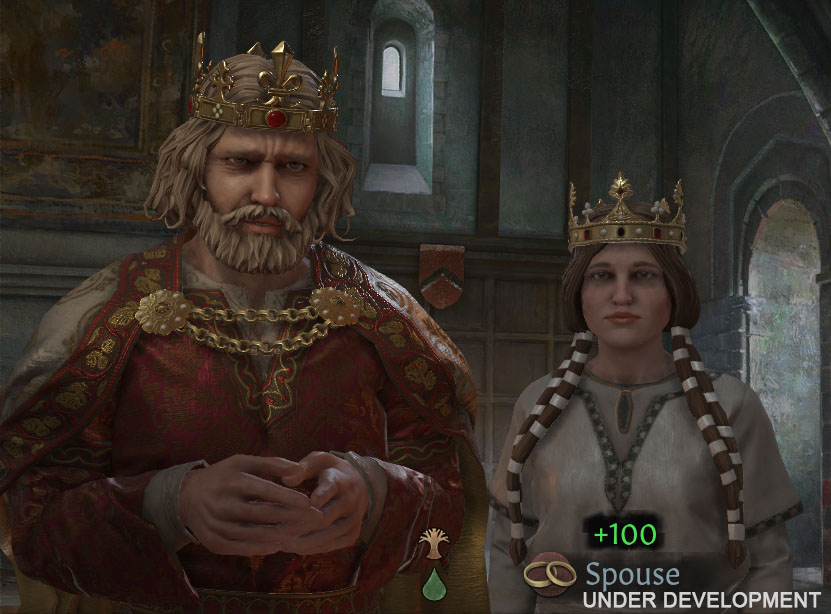
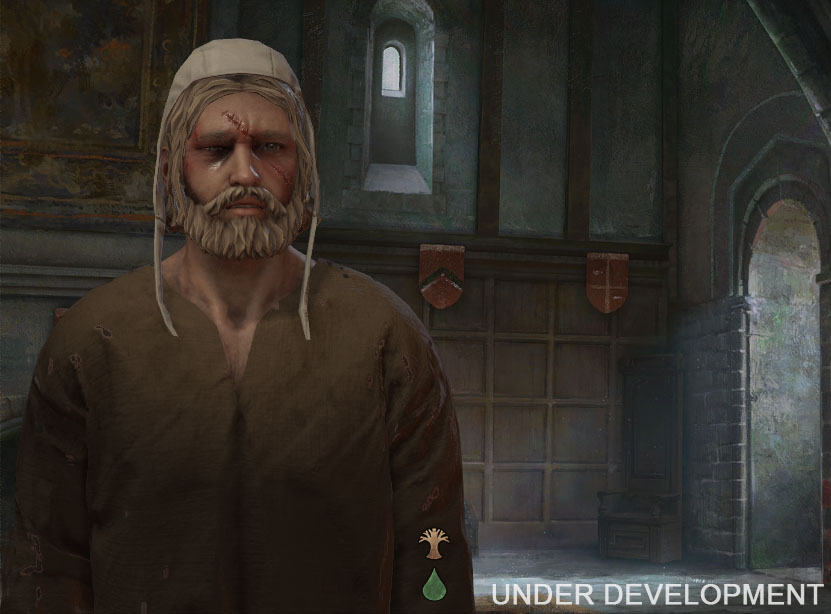
A MEDIEVAL GAME - We made a great effort to keep a good level of historical accuracy in our designs. Our illustrations and icons are made to reflect the time period, just like the 3D art that populate the map. Of course, sometimes we had to try and find good compromises in the designs that would work for the entire timespan of the game.
Where possible, we based clothes on reconstructed sewing patterns from extant medieval clothing. For example, we recreated the "coronation tunic" of Roger II of Sicily, a well preserved garment from the 1130s (though it was actually made some time after the coronation).

Another example would be a loading screen with some really well-painted sunflowers, but these did not exist in europe until the 16th century, which was spotted in time thanks to our Beta testers: so we sent it back to get the flowers repainted…
A ROUGH WORLD - Crusader Kings is not a game for all-ages, you live dangerously and people do terrible, terrible things to each other. This is reflected in the more somber palette and overall mood of the game.
Now, let’s talk about the different types of art you’ll have fun with in CK3:
CHARACTERS
I’m very excited about our new character portraits, and what we can do with them visually. They are varied and have lots of, well, character. Every day there’s a screenshot shared in the dev chat featuring someone they’ve encountered in-game, and we usually agree, yes, that person wears that hat better than most, or indeed, he looks just like the poster boy for the Deviant trait.
For me, the real test for the characters is if they make you feel, and It IS satisfying to throw especially smug-looking Rivals into your Dungeon, and you might feel a bit sorry for some harmless looking characters before you plot to have someone deliver poisonous snakes upon them.
I really want to stress the fantastic work our Lead Character Artist Nils Wadensten and the character team have done in bringing this new generation of portraits to our games, alongside our Engine team.
In fact, he’ll go into the character portraits a bit more in a future diary, hopefully he won’t show the first iterations of the wounds and diseases, some were a bit too much for a lot of people..
For now, I’ll leave you with a sneak peek of Concept art and the final piece of Clothing as how it appears in the game.


ANIMATION
Making the characters move was quite a challenge since the movements need to be very discreet, and not call too much attention to themselves as that could become a distraction from the gameplay.
The posing and idle animations are there to help the immersion and storytelling. Keeping the Rough World pillar in mind, they should not be silly and slapstick - while CK has some wonderful dark humor, we play it straight. I do think the look on a character's face when he realises they are locked up together with a Cannibal is appropriately shocked though.
Generally the characters have a pose that reflects their personality or the situation they’re in.
EVENTS
Here is where the role-playing really kicks in. When an event pops up, we showcase the characters involved and how they feel about the current proceedings, set against a backdrop that really helps sell the setting. This means if you encounter the same event in another play-through, the visuals might be quite different due to the characters involved.
The backdrops have a detailed but hand-painted style that complements our stylized characters’ well. In fact, we have some for you as wallpapers without text, icons and characters obscuring them, enjoy.
When we create a new event background, we also do a hand-crafted lighting setup, which relights the portraits to fit the current scene:
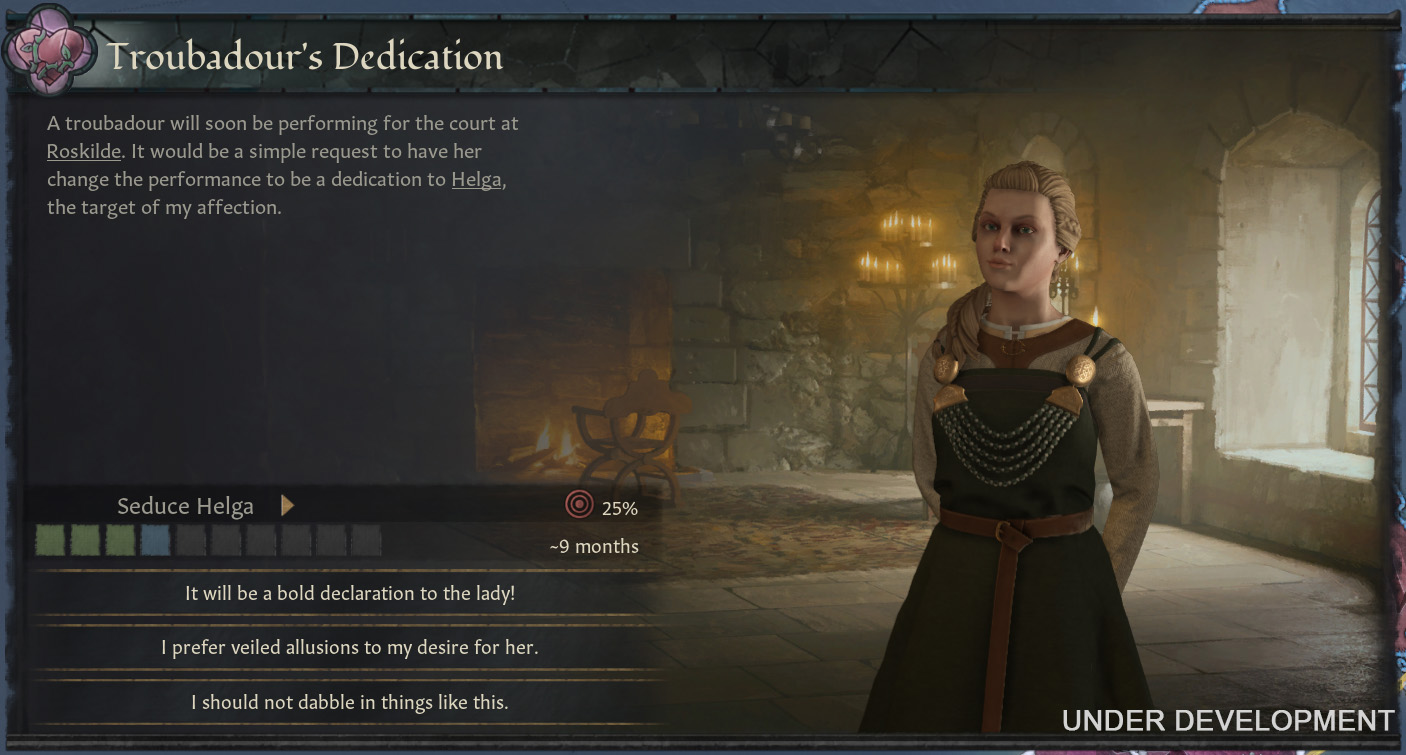
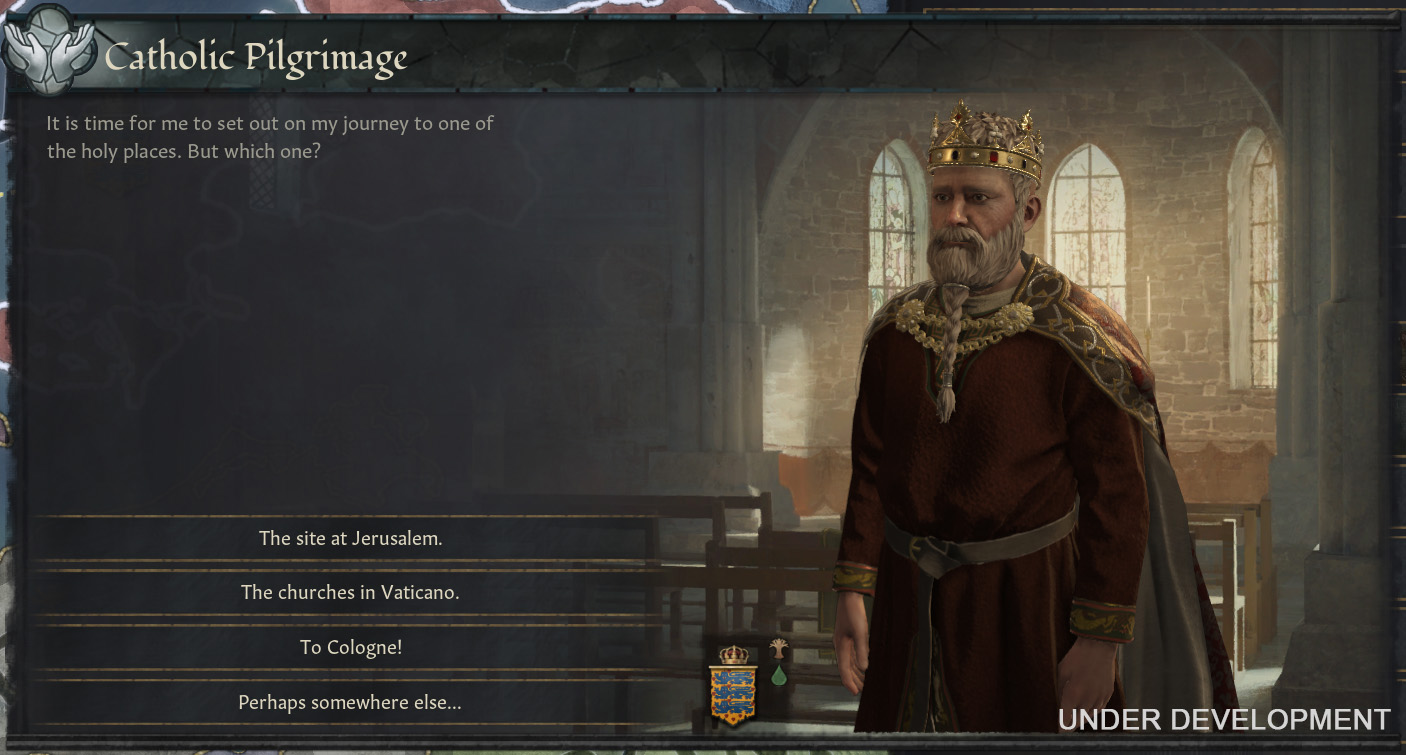


ILLUSTRATIONS
Besides the events, there’s plenty of illustrations in CK3!
For the loading screens, we wanted someone who can do images full of mood and storytelling, in a rough, painterly style. We went straight for the top and asked Craig Mullins. Fortunately, he was up for it, and has provided some really exciting imagery.
They all are of course showcasing aspects of the Crusader Kings experience- from Templars in battle to babies in peril!
Besides the loading screens and event backgrounds, we have cool paintings for Decision categories, terrain types, holdings, army movements, legacies… heck, our Personality trait icons and Tenets are small illustrations - there is a lot to discover and keep you entertained and immersed!

The Holding Illustrations make for great wallpapers as well, so we included that in our art drop!
UNITS
Our units are really cool! We were very enthusiastic about these, and really added quite a bit of detail. Let us know if you spot the nails that stick the shield handle into the shield at the back.
The units’ appearance is based on culture - We have Western European, Byzantine, Middle-east / North Africa, Pagans, Indian and Turko-Mongol.
A unit has three visual tiers, becoming more armor-clad and sophisticated as it progresses. So it was important for us to make sure a Tier 2 Byzantine looks equally as tough as a Tier 2 Turko-Mongol for instance.
They have a lot of spark to them as we added a lot of different animations, they cheer when they win, bang their shields during sieges and we make use of red liquid particles when they land some nice hits.
Culture, Tiers and Coat-of-arms colors and emblems make the Units look appropriate and unique. Here’s some examples:

HOLDINGS
The Holdings were quite a challenge, they needed to be a certain size based on maximum zoom level and minimum Barony size. Since they are small they need to have strong, readable shapes without looking like toys.
Their appearances are influenced by the region they are found in, in this case Western European, Mediterranean, India and Middle-east.
Similar to Units, they have visual tiers, tied to the Holding’s Upgrade level. Temples and Cities have two tiers, whereas Castles and Walls have four tiers.
Of course, we have primitive huts as well, and a big bunch of unique buildings, some easier to recreate (Pyramids) than others (Charlemagne's Palace).


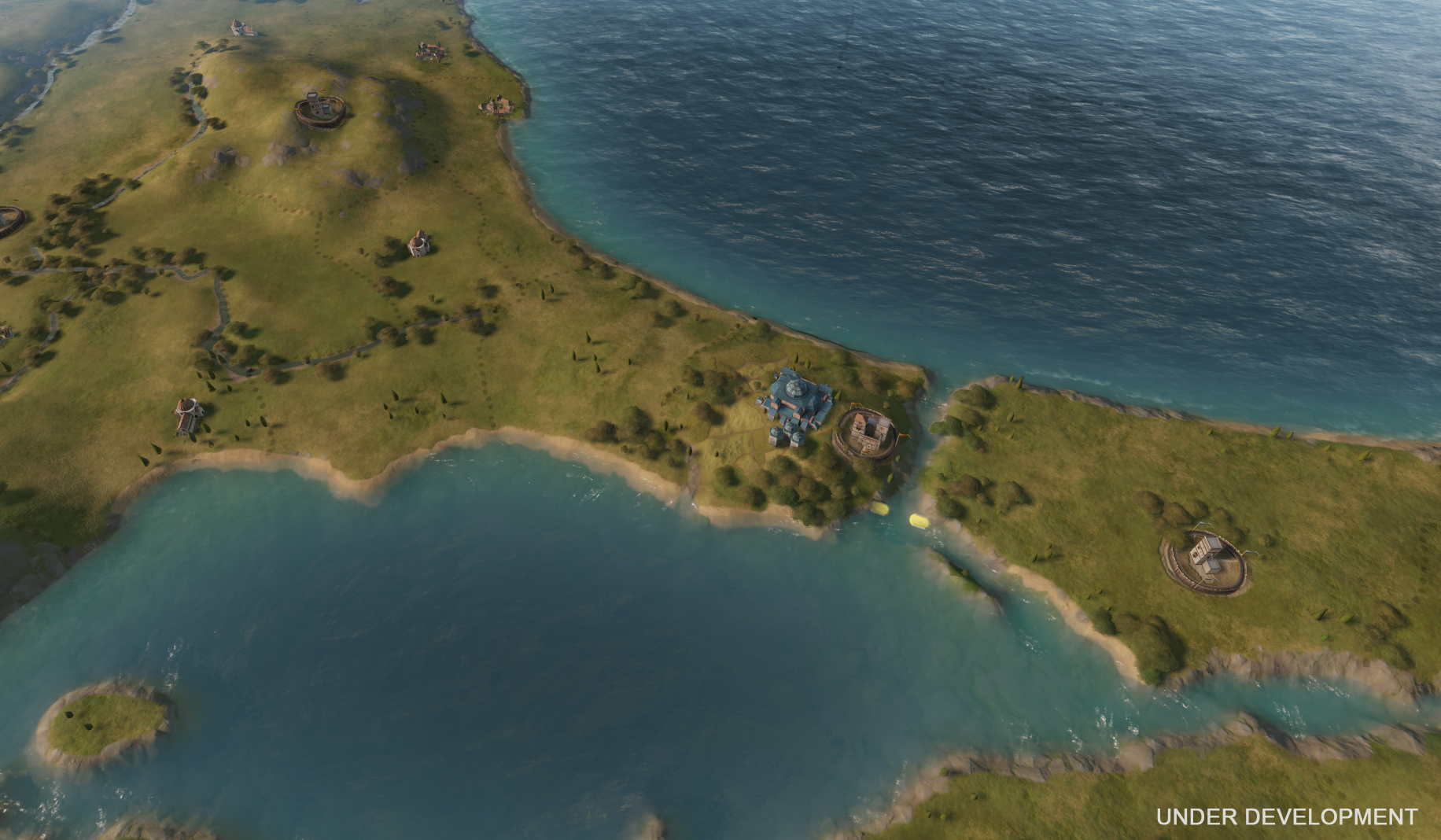

MAP
There’s a rumor going around that some of you CK2 players rarely look at the terrain map. We didn’t want that for CK3, so we made our map to not only be moody and pretty to look at, but also more useful, so you’d have more reasons to go there.
CK is information heavy, so we try to make sure that everything in the terrain map serves a function, and is easy to see. Thus a cleaner look, to make sure the icons, borders, text and 3D models that sit on top of the land read well. At a glance, you should be able to see what terrain type a Barony has without consulting another map mode.
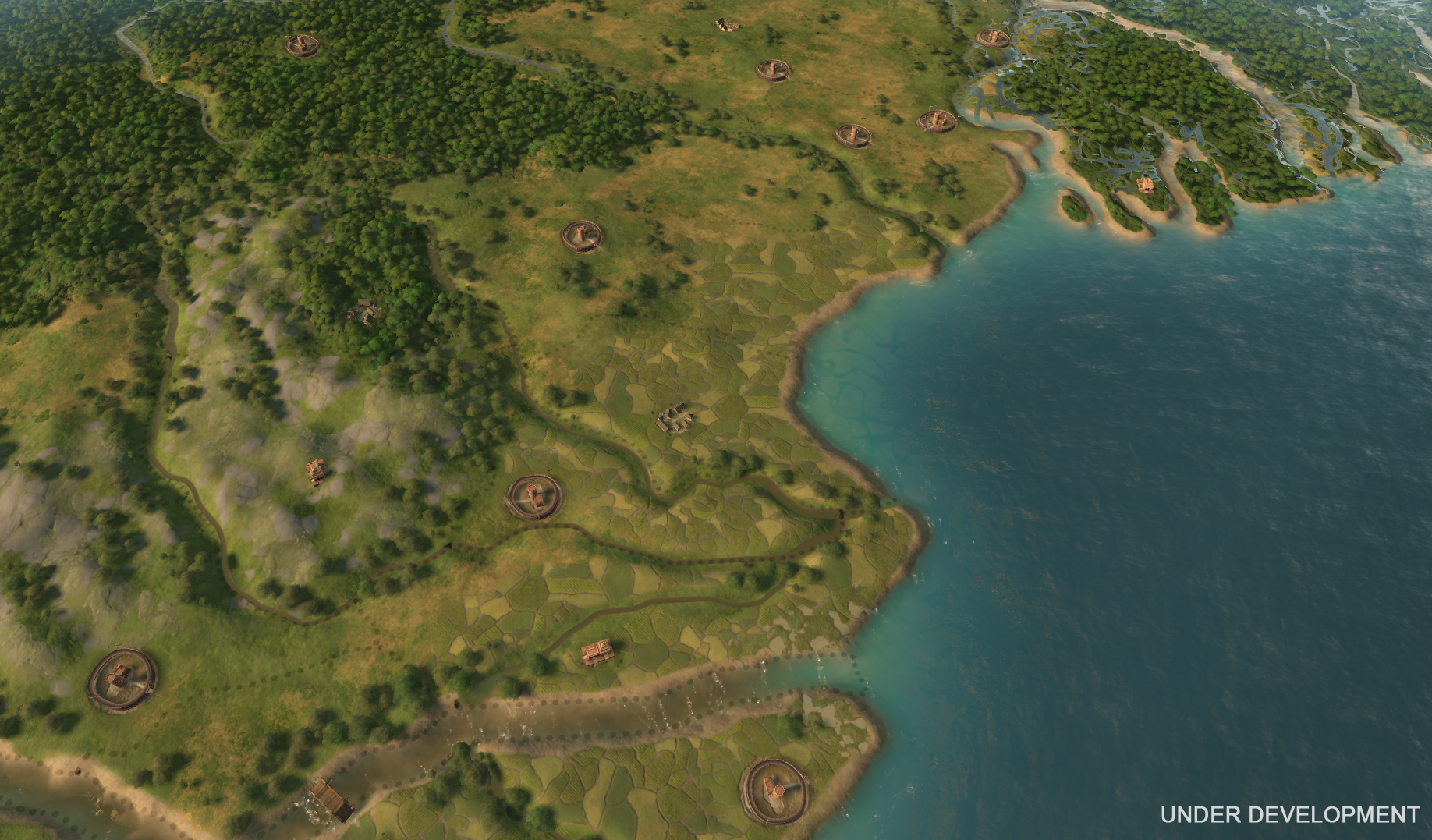
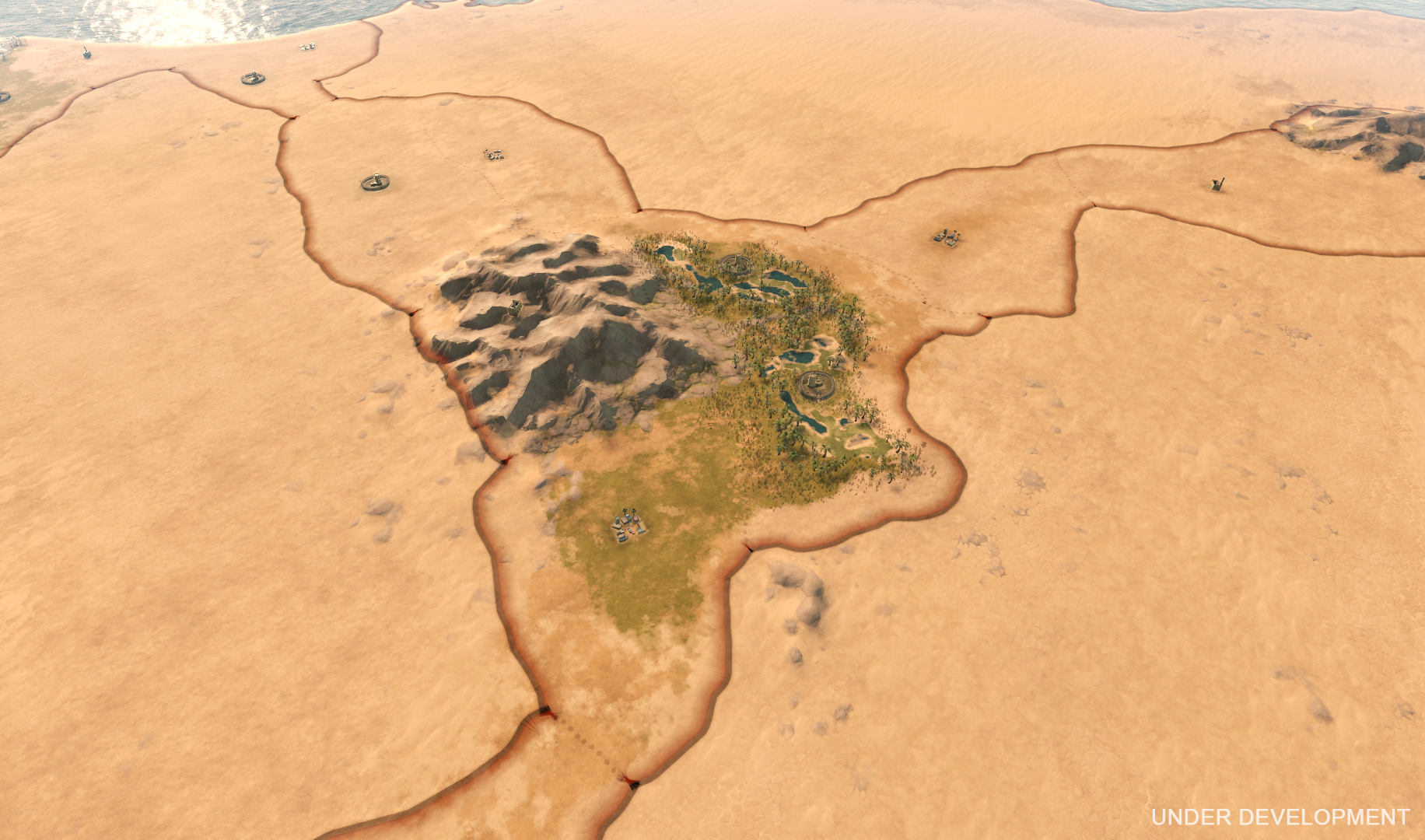
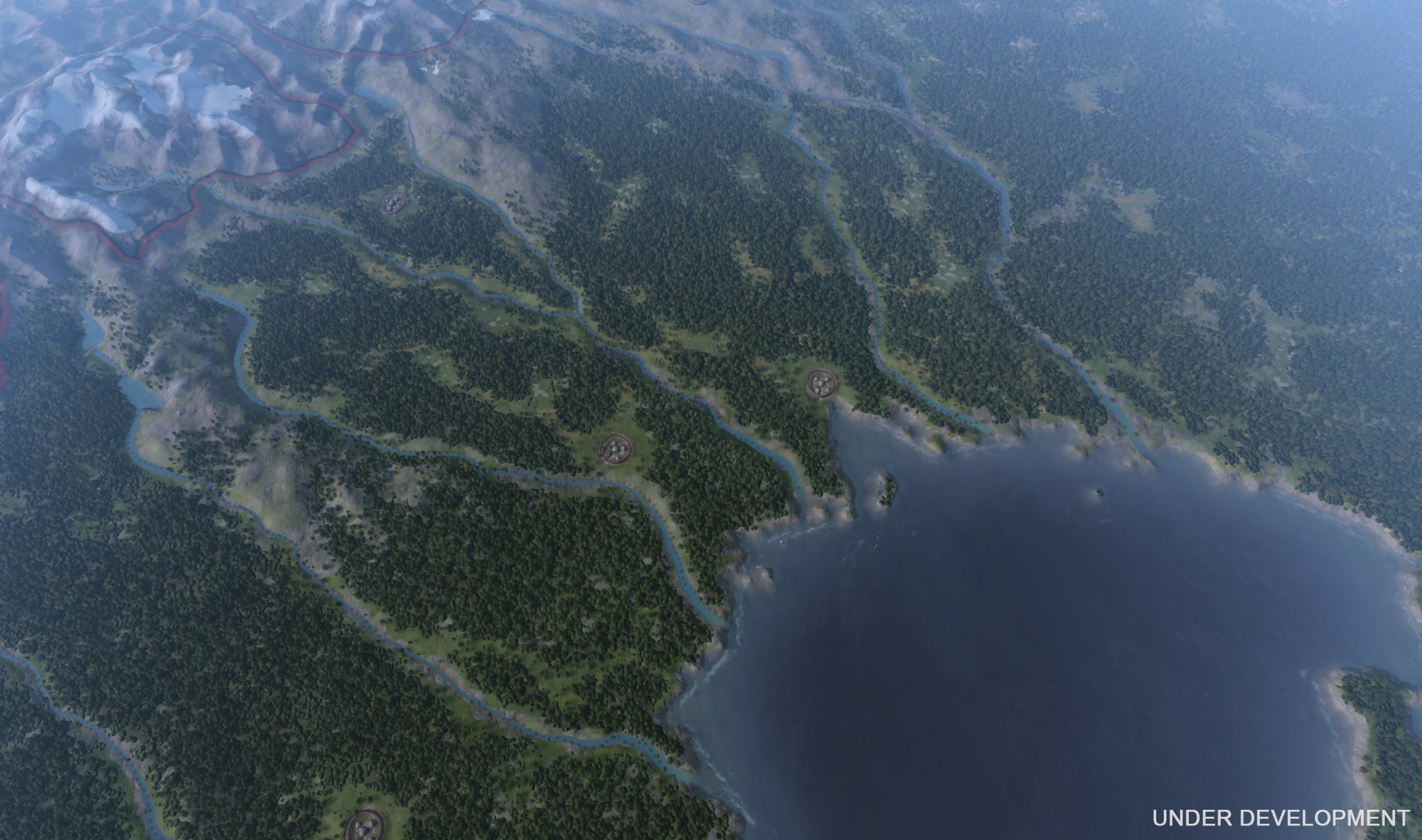
If you are into Political Map modes though, don’t worry, we’ve got you covered. You’ll notice it feels familiar.
It seems our Paper map has been received well, we’re glad you like lobsters too! Getting the right amount of sea-monsters without making it look cluttered wasn’t easy, but I think we managed in the end.

UI
A PDS game has a lot of UI. It is something made in close collaboration with UX and Game Design departments. It is constantly iterated upon and is one of the most challenging aspects of our games.
Visually we took inspiration from game design’s character focus pillar and pulled in visual influences from Roleplaying games. To make it approachable we tried to keep it clean, and give everything some breathing room.
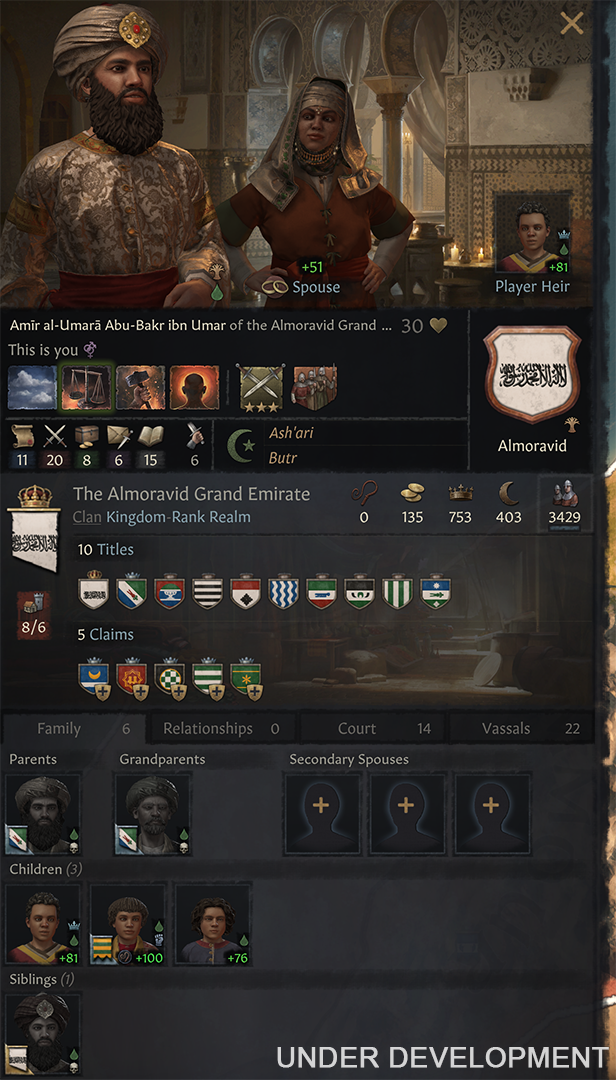

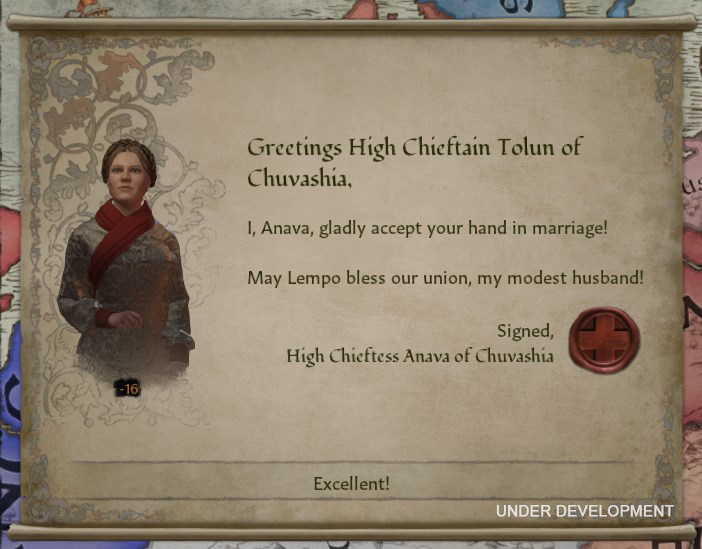
We use a lot of illustrations in our UI’s to help immersion and flavor, and we have a cool system where some of the image types are context sensitive, so for instance your Sultan will not stand in front of a western European throne room if he is hanging out in the Middle-east, and if you are dealing with Catholicism in Religion View, well you’ll see churches and similar imagery.
Coats of Arms
Heraldry is essential to the medieval immersion of Crusader Kings, and so heralds will be excited to hear that we have totally overhauled the Coat of Arms system.
We started from scratch, poring over history books and contemporary armorials to ensure every detail is authentic. We designed accurate CoA for over a thousand titles and dynasties to complement a new scriptable random system that weights hundreds of unique elements based on culture, religion, and everything in between. We modeled minute differences across regions, so frequencies of designs and tinctures are different in Germany, France, and Spain. The amount of possible combinations? Millions.
We achieved our primary goal of making our feudal European heraldry as accurate as possible, but we didn't stop there—we wanted to go into extra depth for all regions. For example, the eastern hordes decorate the Great Steppe with their special tamgha emblems, while the Islamic world is fleshed out with immersive Saracenic heraldry (no more endless stars and crescents). Emergent cadet houses differentiate their new arms by quartering, and yes, England's coat of arms will change if William wins the Norman Invasion.
Here’s some examples of the heraldry system in action - firstly how England’s arms can react to gameplay, and secondly a selection of randomly-generated COA from around the world.


In summary:
The art team has worked very hard and it is a delight every day to see whatever new stuff is coming in. Making games is a group effort though, so we get invaluable help and feedback from the rest of the team: code, design, QA, sound, production all contribute as well.
Of course, seeing pictures in a dev diary is one thing, we can’t wait for you to get your hands on the full experience! As always, your feedback will help guide us as we continue to make content and improvements for CK3!
And for being good sports and reaching the end of the dev diary, here's links to some sweet wallpapers!
http://forumcontent.paradoxplaza.com/public/paradox/banners/ck3-wallpapers.zip
http://forumcontent.paradoxplaza.com/public/paradox/banners/ck3-map-wallpapers.zip
Hello my name is Joacim, Art Lead on Crusader Kings 3, I am positing here a developer diary written by Pontus, Art Director on Crusader Kings 3, currently on paternity leave. Our artists will reply to your questions in the comments!
Art Focus
Hey! Let’s talk about the art of Crusader Kings III!
My name is Pontus, Art Director on CK3. I’ve written this dev diary together with the art team, and if you promise to tell everyone this is the best dev diary so far, there will be some sweet wallpapers at the end of it. Cool?
Certainly, you’ve seen a lot of the art already, in various states of completion, with all our diaries and previews. Let’s start by talking about the way we’ve approached creating the graphics for the game!
The starting point for the art direction is, as it should be, the game design. If you recall Dev Diary #0, Henrik Fåhreus’ vision of the game has a big focus on characters and storytelling, as well as approachability and player freedom. Reinforcing that through the art has been the main goal.
To keep ourselves on-track, three key pillars guide the art department on CK3:
A ROLE-PLAYING EXPERIENCE - This pillar is represented by our goal to give life to the characters and their unfolding stories. An example of this would be the characters’ portraits, we did not want them small and static, they are now front and center, and show off their standing or lack thereof through clothing, as well as show how they feel about what is happening to them through body language.


A MEDIEVAL GAME - We made a great effort to keep a good level of historical accuracy in our designs. Our illustrations and icons are made to reflect the time period, just like the 3D art that populate the map. Of course, sometimes we had to try and find good compromises in the designs that would work for the entire timespan of the game.
Where possible, we based clothes on reconstructed sewing patterns from extant medieval clothing. For example, we recreated the "coronation tunic" of Roger II of Sicily, a well preserved garment from the 1130s (though it was actually made some time after the coronation).

Another example would be a loading screen with some really well-painted sunflowers, but these did not exist in europe until the 16th century, which was spotted in time thanks to our Beta testers: so we sent it back to get the flowers repainted…
A ROUGH WORLD - Crusader Kings is not a game for all-ages, you live dangerously and people do terrible, terrible things to each other. This is reflected in the more somber palette and overall mood of the game.
Now, let’s talk about the different types of art you’ll have fun with in CK3:
CHARACTERS
I’m very excited about our new character portraits, and what we can do with them visually. They are varied and have lots of, well, character. Every day there’s a screenshot shared in the dev chat featuring someone they’ve encountered in-game, and we usually agree, yes, that person wears that hat better than most, or indeed, he looks just like the poster boy for the Deviant trait.
For me, the real test for the characters is if they make you feel, and It IS satisfying to throw especially smug-looking Rivals into your Dungeon, and you might feel a bit sorry for some harmless looking characters before you plot to have someone deliver poisonous snakes upon them.
I really want to stress the fantastic work our Lead Character Artist Nils Wadensten and the character team have done in bringing this new generation of portraits to our games, alongside our Engine team.
In fact, he’ll go into the character portraits a bit more in a future diary, hopefully he won’t show the first iterations of the wounds and diseases, some were a bit too much for a lot of people..
For now, I’ll leave you with a sneak peek of Concept art and the final piece of Clothing as how it appears in the game.


ANIMATION
Making the characters move was quite a challenge since the movements need to be very discreet, and not call too much attention to themselves as that could become a distraction from the gameplay.
The posing and idle animations are there to help the immersion and storytelling. Keeping the Rough World pillar in mind, they should not be silly and slapstick - while CK has some wonderful dark humor, we play it straight. I do think the look on a character's face when he realises they are locked up together with a Cannibal is appropriately shocked though.
Generally the characters have a pose that reflects their personality or the situation they’re in.
EVENTS
Here is where the role-playing really kicks in. When an event pops up, we showcase the characters involved and how they feel about the current proceedings, set against a backdrop that really helps sell the setting. This means if you encounter the same event in another play-through, the visuals might be quite different due to the characters involved.
The backdrops have a detailed but hand-painted style that complements our stylized characters’ well. In fact, we have some for you as wallpapers without text, icons and characters obscuring them, enjoy.
When we create a new event background, we also do a hand-crafted lighting setup, which relights the portraits to fit the current scene:




ILLUSTRATIONS
Besides the events, there’s plenty of illustrations in CK3!
For the loading screens, we wanted someone who can do images full of mood and storytelling, in a rough, painterly style. We went straight for the top and asked Craig Mullins. Fortunately, he was up for it, and has provided some really exciting imagery.
They all are of course showcasing aspects of the Crusader Kings experience- from Templars in battle to babies in peril!
Besides the loading screens and event backgrounds, we have cool paintings for Decision categories, terrain types, holdings, army movements, legacies… heck, our Personality trait icons and Tenets are small illustrations - there is a lot to discover and keep you entertained and immersed!

The Holding Illustrations make for great wallpapers as well, so we included that in our art drop!
UNITS
Our units are really cool! We were very enthusiastic about these, and really added quite a bit of detail. Let us know if you spot the nails that stick the shield handle into the shield at the back.
The units’ appearance is based on culture - We have Western European, Byzantine, Middle-east / North Africa, Pagans, Indian and Turko-Mongol.
A unit has three visual tiers, becoming more armor-clad and sophisticated as it progresses. So it was important for us to make sure a Tier 2 Byzantine looks equally as tough as a Tier 2 Turko-Mongol for instance.
They have a lot of spark to them as we added a lot of different animations, they cheer when they win, bang their shields during sieges and we make use of red liquid particles when they land some nice hits.
Culture, Tiers and Coat-of-arms colors and emblems make the Units look appropriate and unique. Here’s some examples:

HOLDINGS
The Holdings were quite a challenge, they needed to be a certain size based on maximum zoom level and minimum Barony size. Since they are small they need to have strong, readable shapes without looking like toys.
Their appearances are influenced by the region they are found in, in this case Western European, Mediterranean, India and Middle-east.
Similar to Units, they have visual tiers, tied to the Holding’s Upgrade level. Temples and Cities have two tiers, whereas Castles and Walls have four tiers.
Of course, we have primitive huts as well, and a big bunch of unique buildings, some easier to recreate (Pyramids) than others (Charlemagne's Palace).




MAP
There’s a rumor going around that some of you CK2 players rarely look at the terrain map. We didn’t want that for CK3, so we made our map to not only be moody and pretty to look at, but also more useful, so you’d have more reasons to go there.
CK is information heavy, so we try to make sure that everything in the terrain map serves a function, and is easy to see. Thus a cleaner look, to make sure the icons, borders, text and 3D models that sit on top of the land read well. At a glance, you should be able to see what terrain type a Barony has without consulting another map mode.



If you are into Political Map modes though, don’t worry, we’ve got you covered. You’ll notice it feels familiar.
It seems our Paper map has been received well, we’re glad you like lobsters too! Getting the right amount of sea-monsters without making it look cluttered wasn’t easy, but I think we managed in the end.

UI
A PDS game has a lot of UI. It is something made in close collaboration with UX and Game Design departments. It is constantly iterated upon and is one of the most challenging aspects of our games.
Visually we took inspiration from game design’s character focus pillar and pulled in visual influences from Roleplaying games. To make it approachable we tried to keep it clean, and give everything some breathing room.



We use a lot of illustrations in our UI’s to help immersion and flavor, and we have a cool system where some of the image types are context sensitive, so for instance your Sultan will not stand in front of a western European throne room if he is hanging out in the Middle-east, and if you are dealing with Catholicism in Religion View, well you’ll see churches and similar imagery.
Coats of Arms
Heraldry is essential to the medieval immersion of Crusader Kings, and so heralds will be excited to hear that we have totally overhauled the Coat of Arms system.
We started from scratch, poring over history books and contemporary armorials to ensure every detail is authentic. We designed accurate CoA for over a thousand titles and dynasties to complement a new scriptable random system that weights hundreds of unique elements based on culture, religion, and everything in between. We modeled minute differences across regions, so frequencies of designs and tinctures are different in Germany, France, and Spain. The amount of possible combinations? Millions.
We achieved our primary goal of making our feudal European heraldry as accurate as possible, but we didn't stop there—we wanted to go into extra depth for all regions. For example, the eastern hordes decorate the Great Steppe with their special tamgha emblems, while the Islamic world is fleshed out with immersive Saracenic heraldry (no more endless stars and crescents). Emergent cadet houses differentiate their new arms by quartering, and yes, England's coat of arms will change if William wins the Norman Invasion.
Here’s some examples of the heraldry system in action - firstly how England’s arms can react to gameplay, and secondly a selection of randomly-generated COA from around the world.


In summary:
The art team has worked very hard and it is a delight every day to see whatever new stuff is coming in. Making games is a group effort though, so we get invaluable help and feedback from the rest of the team: code, design, QA, sound, production all contribute as well.
Of course, seeing pictures in a dev diary is one thing, we can’t wait for you to get your hands on the full experience! As always, your feedback will help guide us as we continue to make content and improvements for CK3!
And for being good sports and reaching the end of the dev diary, here's links to some sweet wallpapers!
http://forumcontent.paradoxplaza.com/public/paradox/banners/ck3-wallpapers.zip
http://forumcontent.paradoxplaza.com/public/paradox/banners/ck3-map-wallpapers.zip





Yeah,westerners were always weird.People tend to underestimate importance of clothes in medieval times. If you read some juridical recordings then you'll see how important clothes were to people back then and that undressing was a type of TORTURE, as a kind of removing prestige and class destinction tells a lot.




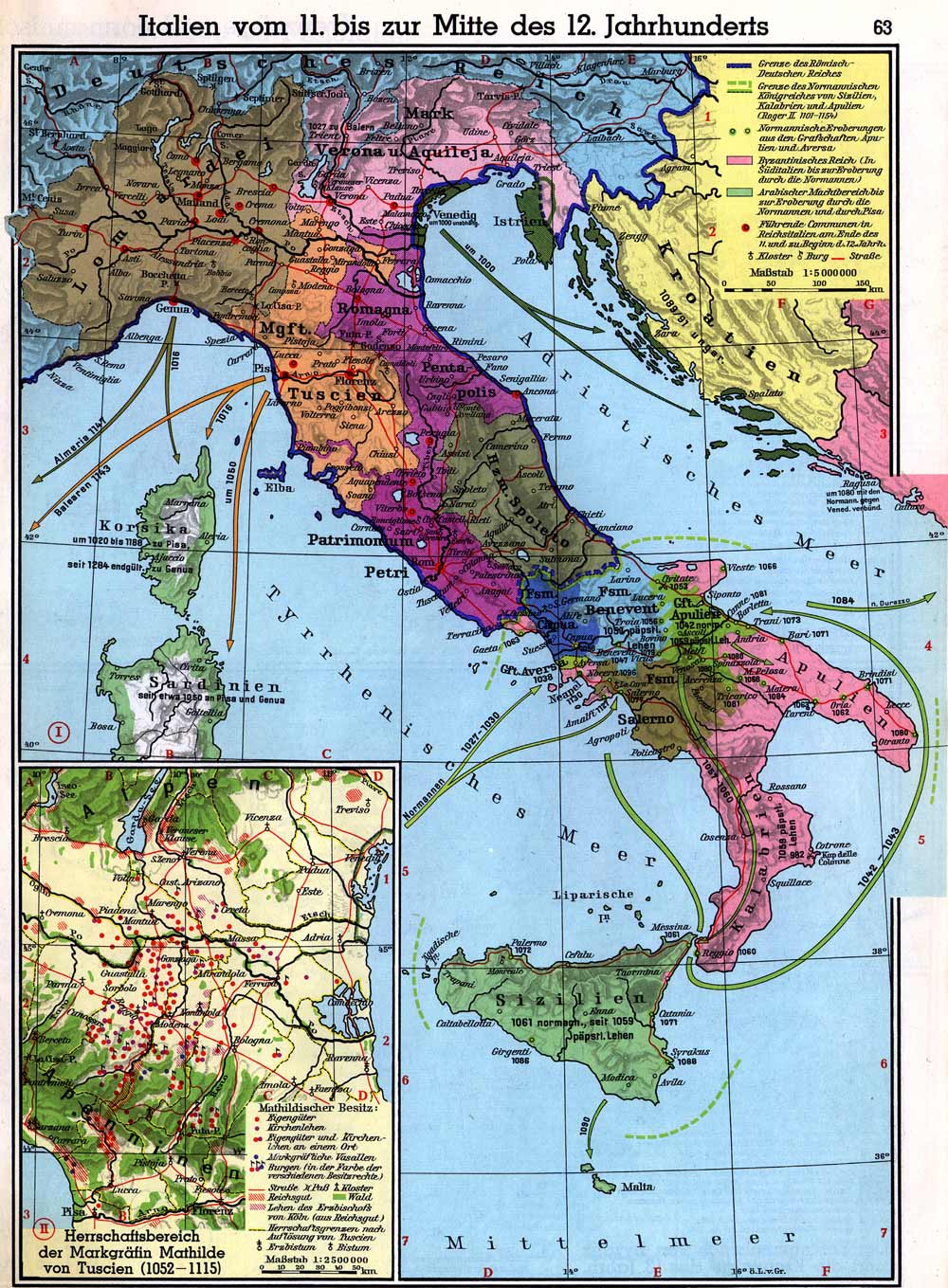

Oh and also italy lol buahahahahahaha.



It seems you could build great buildings in any province lol.Oh and also italy lol buahahahahahaha.
the map life posted was the 9th century ('old gods') start. still weird warp of the byzantine's territory at that time imo.
do they claim to be trying to balance the map for gameplay? i hope not.
Come one, come all, and hear the tale of Kalevi of Karelia. We’ll follow him on the perilous road from High Chieftain of a few counties to King and defender of Ukko as a Holy Warrior! We will pay close attention to what choices he makes to further his agenda, for what is life but the decisions you make along the way?

Surprise surprise, in this dev diary we will take a closer look at Decisions: what they are and how they work. The easy way to describe a Decision is that they are an action a ruler can take, but they end up being so much more than that over the course of a game!
We’ve focused on adding a wide spread of Decisions in the game so that you will have unique experiences playing different characters all over the map.

[Two examples of what the decision view might look like for different characters]
There are two types of Decisions: Major Decisions and… well, Decisions. Major Decisions are displayed in a prominent position at the top of the interface and can be viewed as something to work towards, if you want; we have designed them to give the player a rewarding goal – a kind of mission. Major Decisions are often life-changing and their effects will be felt throughout the world; you can make decisions that affect your whole dynasty, or a whole religion. Examples of Major Decisions are “Found a New Kingdom”, “Consecrate Bloodline” and, of course, “Mend the Great Schism”.
Regular Decisions, on the other hand, can function as a means to reach those lofty goals and are often more accessible and more immediately relevant to your everyday life as a ruler. Decisions cover a wide range of actions you can take, everything from “Host Feast” to “Flagellate”. This gives you a lot of control over what actions your character takes and how you shape your realm.
So, back to Kalevi of Karelia. Our story begins just as the young High Chieftain Kalevi, only 16 years of age, has stepped into the role of a ruler after his father’s passing. Orthodoxy is spreading upward from the south, Catholicism is a growing concern in the west, and Kalevi wants nothing more than to protect the old ways and the Suomenusko faith he was brought up with. It might seem like a big task for any lone man, but he has a plan! He intends to raise a Hall of Heroes and lay the foundations for Holy Warriors to defend the faith.

The road ahead might seem long and taxing, but such is the way of life when your goal is as lofty as this.
He does currently stand alone at the rudder, however, and he wishes for a companion – a spouse. As luck would have it he stumbles across a skillful and beautiful peasant woman when he is out hunting!


Together they start a new family, and the first Decision among many has been made.
One of the requirements to fortify a Holy Site, by taking the Major Decision “Defenders of Ukko”, is to have a Holy Site to fortify. After a quick glance at the Suomenusko Holy Sites, Kalevi’s gaze settles on Raivola in Kakisalmi, currently under the control of his neighbor Chieftain Susi. Susi believes in the right Gods, but Kalevi doubts he would allow other people access to the Holy Site... War it is, then.

To tip the scales in his favor, Kalevi decides to send out heralds to let it be known that he is searching for Champions to join him. Soon he has bolstered his forces enough to take on his neighbor.
After the war Kalevi is perplexed… He has a Holy Site under his control, and he has the will; why won’t the people help him build the Hall of Heroes? Why won’t they help him defend the true faith? Then it hits him: he doesn’t have enough strong people backing him, and he is not known to be pious enough to inspire the respect needed. This realization sets Kalevi down a path of many years of character-building, in the form of pious endeavors, and realm-building, in the form of conquest and vassalization, until he has founded his own Kingdom.

As his realm stabilizes he realizes what must follow; he needs to go on a pilgrimage to truly understand the Suomenusko faith.

However, during his pilgrimage Kalevi is grievously wounded! Word is sent out that the court is looking for a physician, and soon enough his wounds have been tended, but the scars will forever mar him.
Gaining traits, like Wounded, might spur you to make a Decision you otherwise wouldn’t, and Decisions can also become available through traits, events, and a myriad of other changing conditions in the game. If you find a Decision particularly interesting you can mark it as important and you will then get an alert when the conditions are met and you can take the Decision!
For Kalevi a lot of time has passed. Finally, at the tender age of 60 and a life full of decisions small and great behind him, King Kalevi of Karelia finds the support needed to fortify a Holy Site and bolster the defense of Suomenusko.

Who knows what will follow for Kalevi; maybe he’ll Found a New Empire to stabilize the region further, or perhaps he’ll Adopt Feudal Ways in a bid to – at long last – attempt to develop the region in a new direction. But one thing is for certain: the threat of Christianity has done nothing but grow during all these years…
Thank you for reading and see you next week!



Either way, i expect tons of butthurt, similar to Imperator, when this goes out.

It will be a dissappointment, like Imperator Rome. They will either change it a lot and make it bare bones to sell hundrends of tiny DLC for those sweet sweet shekels, or they will change nothing at all and will play it safe but will still sell it barebones in order to sell hundrends of tiny DLC for those sweet sweet shekels. Either way, i expect tons of butthurt, similar to Imperator, when this goes out.







